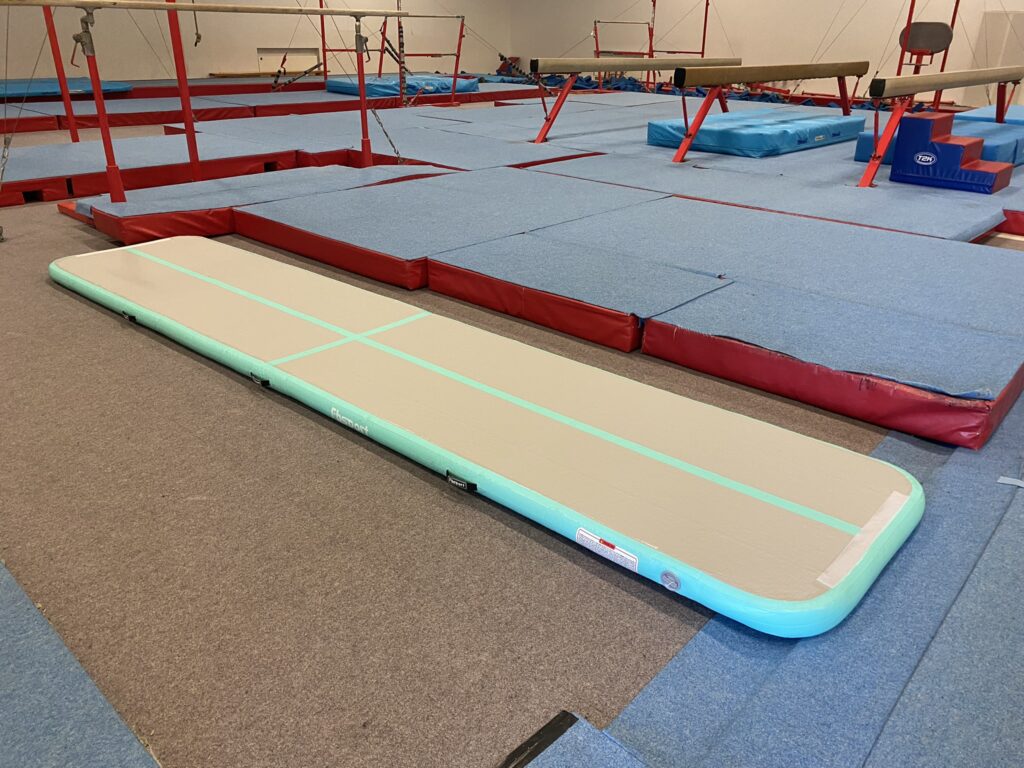
This guide delves deep into the Level 5 gymnastics skills, providing insights, breakdowns, and an expert perspective on each skill and its significance in a gymnast’s developmental journey.
Whether you’re a coach, a gymnast, or an enthusiast, this comprehensive guide will offer valuable insights into the complexities and difficulties of Level 5 gymnastics in the Women’s Development Program.
An Overview of Level 5
Level 5 fits in the middle of the 10-level WDP structure which was formerly known as the Junior Olympic Program. Level 5 is the second compulsory level meaning that routines are set by the USAG and all gymnasts perform the same routines as each other.
Girls must have reached their 7th birthday to take part in a level 5 meet and will need to have met the level 4 mobility score already.
If you haven’t familiarized yourself with the previous level requirements you can do so here:
- Level 1 Gymnastics Requirements
- Level 2 Gymnastics Requirements
- Level 3 Gymnastics Requirements
- Level 4 Gymnastics Requirements
Gymnasts will be aiming to meet the level 5 mobility score to progress to level 6. The mobility score required is 34AA. This means gymnasts must score a combined total of 34 points on all four pieces; Floor, Beam, Uneven Bars and Vault.
Level 5 Floor Routine
The level 5 floor routine includes the following skills:
- Front Tuck Somersault or Aerial Cartwheel or Front Aerial
- Front handspring step-out x2 into Cartwheel into Back Extension Roll
- Stretch Jump with a Full turn
- Straddle jump
- Forward splits
- Spin Full Turn
- Round off back handspring back tuck
As a compulsory level, all gymnasts perform the same floor routine and the major skills are linked using dance elements and gymnastics poses. The artistry used when linking the skills is vitally important as the judges deduct heavily unless the routine flows and has rhythm.
Many gymnasts will take the option of Front Tuck over Aerial in their routines. Although front tuck is a difficult tumbling move it is not as tricky as an aerial for most people. As a compulsory routine there is no difference in difficulty score for either option and gymnasts should go with the skill they are personally more confident with.
The Front Handspring section is another difficult tumbling pass that requires a lot of training time and strength work to ensure correct technique and form. As with all tumbling passes, the skills should flow from one to another without hesitation or pause in between.
The middle part of the routine incorporates most of the flexibility work and gymnasts will be expected to dance through this section with excellent posture and demonstrate that they can hit the lines needed for great flexibility.
The final section of the routine includes another tumbling pass with Round off, back handspring, back tuck. Girls will need to focus on creating lots of power through their snap down in round off and back handspring and show lots of height as they take off into the back tuck.
This type of backward tumbling pass is repeated a lot in girl’s floor routines and it’s vital that correct technique is demonstrated at this level or else it will be difficult to add the various other back somersaults needed in higher levels.
If gymnasts want to work on their tumbling skills at home I recommend investing in an inflatable air mat.

Level 5 Floor Music
The level 5 floor music is the same for all gymnasts and is available on the USAG YouTube channel. The channel is extremely useful as it provides both the whole track and smaller individual sections that can be used in practice.
Level 5 Beam Routine
At level 5 girls will need to perform a beam routine that includes the following major skills:
- Back Handspring step out or Front walkover or Back walkover or Back extension roll
- Straight leg leap with 150 degrees leg separation
- Split jump, sissone
- Full turn
- Scale (arabesque)
- Cartwheel
- Back tuck dismount
The level 5 beam routine includes a number of tricky skills that require a lot of practice in the gym. The routine begins with an option of four skills, the Back handspring step out being the most challenging. However, if a gymnast has mastered this skill and its ready to be performed at a meet it makes sense to go for it. At subsequent levels, the Back handspring on the beam is essential so there’s no point holding it back if it’s ready.

You should also consider that by performing the more impressive back handspring correctly, it will make an impression on the judges. And whilst there is no bonus score for including it, a positive impression at the beginning of the routine may influence the judges thoughts as they score the rest of the routine.
Level 5 Bar Routine
The level bar routine is constructed using the following set skills:
- Kip
- Squat onto the low bar or Back Sole Circle
- Long hang Kip
- Cast above horizontal
- Back Sole Circle to clear Front Support or Back Stalder Circle to Clear Front Support
- Long Hang Pullover
- Tap swings
- Flyaway dismount
Just as on Beam and Floor, the Bar routine is increasing significantly in difficulty at level 5. It sees the introduction of the first somersault dismount in the flyaway and Kips on both low bar and high bar.
Level 5 Gymnastics Vault
The level 5 vault is Front Handspring which is exactly the same as level 4.
FAQs
How old are girls in level 5 gymnastics?
Girls must be a minimum of 7 years old before the competition. There is no maximum age.
Can a gymnast skip level 5?
No, a gymnast cannot skip level 5.
How do you move up to level 5 in gymnastics?
You must have taken part at a USAG-sanctioned level 4 meet and scored a minimum of 34AA.
How do you move up to level 6?
To move up to level 6 you must be at least 7 years old and have scored a minimum of 34AA at a level 5 meet sanctioned by the USAG.
- How to Do a Back Handspring: Complete Step-by-Step GuideLearning how to do a back handspring is an exciting milestone for any gymnast. It builds confidence, agility, and forms the foundation for advanced tumbling… Read more: How to Do a Back Handspring: Complete Step-by-Step Guide
- How To Get Over a Mental Block In Gymnastics: A Complete GuideGymnastics is a sport that requires not only physical strength and skill but also mental strength. When a gymnast feels like they cannot attempt a… Read more: How To Get Over a Mental Block In Gymnastics: A Complete Guide
- The Best Leotard for Girls in 2025: What to Look ForFinding an ideal leotard for girls isn’t just about picking a dazzling design that sparkles (although it does help!). The leotard has to fit perfectly,… Read more: The Best Leotard for Girls in 2025: What to Look For
- The Best Gymnastics Shorts (Our Top Picks)The best gymnastics shorts are designed to be worn over the top of a leotard providing additional coverage around the upper legs, whilst allowing gymnasts… Read more: The Best Gymnastics Shorts (Our Top Picks)
- Decathlon Leotards – Are They Any Good?If you’re in the market for a new leotard, you may be wondering if Decathlon leotards are any good considering the low cost of their… Read more: Decathlon Leotards – Are They Any Good?
- A Complete Guide to Gymnastics Hand RipsAre you tired of dealing with painful gymnastics rips on your hands from training? Look no further – this article offers a comprehensive approach to… Read more: A Complete Guide to Gymnastics Hand Rips






